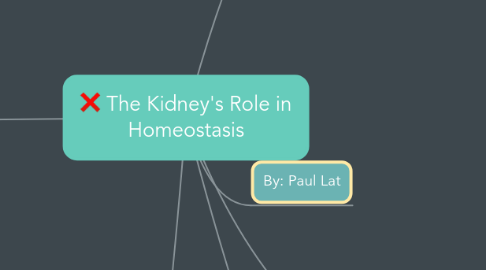
1. Structure of Kidney
1.1. Nephron: Maintain extracellular and intracellular fluid volumes also maintains electrolyte concentration.
1.1.1. Two components
1.1.1.1. Vascular
1.1.1.2. Tubular
1.1.2. Cortex: Collection of 90% of renal blood flow, circulating at 4.5mL/min
1.1.2.1. Afferent Artriole
1.1.2.2. Efferent Artriole
1.1.2.3. Glomerulus
1.1.2.4. Peritubular capillary
1.1.2.5. Vasa recta
1.1.2.6. Bowman's Capsule
1.1.2.7. Proximal Tubule
1.1.2.8. Distal Tubule
1.1.3. Medulla: Circulates renal blood flow at 1mL/ min
1.1.3.1. Loop of Henle
1.1.3.1.1. Descending Limb
1.1.3.1.2. Ascending Limb
1.1.3.2. Cortical collecting tubule
1.1.3.3. Medullary collecting duct
2. References:
2.1. McLafferty, E., Johnston, C., Hendry, C. & Farley, A. (2014). Fluid and electrolyte balance. Nursing Standard, 28(29), 42-49.
2.2. American Nephrology Nurses Association. (2015). Core Curriculum for Nephrology Nursing (6th ed.): Module 2. Pitman, New Jersey.
3. Process of Homeostasis
3.1. 1. Filtration
3.1.1. Filtration of water and other small molecules from plasma generated by Blood pressure
3.1.1.1. Mainly occurs within the Glomerules --> Bowman's Capsule
3.1.1.1.1. 1 to 2 litres of filtrate excreted as urine but 99% of filtrate reabsorbed and moved into the tubules.
3.2. 2. Reabsorption
3.2.1. Movement of substances from tubular filtrate into the plasma of peritubular capillaries. Reabsorption needed to avoid volume depletion.
3.2.1.1. Mainly occurs within Proximal tubules (65%) remaining occurs within Henle's loop, distal tubules, cortical collecting tubule, and medullary collecting duct.
3.2.1.1.1. Reabsorption through the process of passive and active transport mechanisms
3.3. 3. Secretion
3.3.1. Movement of substances from peritubular capillaries into tubular capillaries; process of reabsorption but reversed.
3.3.1.1. Mainly occuring in the proximal tubule. With the use of active and passive processes.
3.3.1.1.1. Secretion of potasium, hydrogen ions, ammonia, uric acid, exogenous substanceand other wastes.
3.3.1.1.2. Protein bound metabolite or drugs must be actively secreted.
3.3.1.1.3. Secretion of extra potassium with the use of aldosterone occuring within the collecting ducts and distal convulated tubules.
3.4. 4. Excretion
3.4.1. Removal of water and solutes from the body.
3.4.1.1. Filtrate is eventually turned into urine which is then excreted.
3.4.1.1.1. Within the tip of the pyramid within the loop of henle are branches called calyces which collect urine which are a part of other calyces which form the ureter which leads to the renal pelvis, transporting urine to the ureters to go out to the bladder then out the ureter which is the excretion of waste via urine.
4. Kidney's Role
4.1. Maintain body fluids through the process of filtration, reabsorption, secretion, and excretion.
4.1.1. Maintenance of
4.1.1.1. Water (Osmolality)
4.1.1.1.1. Water is filtrated through the glomerus into the bowman's capsule.
4.1.1.1.2. 65% of water passively reabsorbed from the proximal tubule
4.1.1.2. Minerals (Calcium, phosphorus, magnesium)
4.1.1.2.1. 65% of Calcium reabsorbed in Proximal Tubule
4.1.1.2.2. Most phosphate reabsorbed from the proximal tubule, excess phosphate is exreted.
4.1.1.2.3. 25% of Magnesium reabsorbed in the proximal tubule.
4.1.1.3. Sodium
4.1.1.3.1. 65% of filtered sodium reasbored through the Proximal Tubule.
4.1.1.3.2. Hyponatremia: Impared ADH secretion
4.1.1.4. Amino acid
4.1.1.4.1. 100% of filtered amino acids are reabsorbed
4.1.1.5. Glucose
4.1.1.5.1. reabsorbed into the peritubular capillaries by cotransport with sodium, 100% of filtered glucose is reabsorbed
4.1.1.6. Potassium
4.1.1.6.1. 65% of potassium reabsorbed from the proximal tubule by cotransport with sodium
4.1.1.6.2. Hyperkalemia: Inabilty to excrete potassium leading to high potassium levels.
4.1.1.7. Chloride
4.1.1.7.1. Chloride passively reabsorbed from the proximal tubule
4.1.1.8. Waste (urea, creatinine, uric acid)
4.1.1.8.1. Urea reabsorbed from the proximal tubule
4.1.1.8.2. 10% of filtered creatinine is secreted into the proximal tubule.
4.1.1.9. Acid/ Base (Bicarbonate, hydrogen ions)
4.1.1.9.1. Occurs within the proximal tubule, distal tubule, and collecting duct
5. By: Paul Lat
6. Use of Homeostasis Example
6.1. Acid Base Imbalance
6.1.1. Acid Urine
6.1.1.1. pH of body fluids in acid range
6.1.1.1.1. Kidneys excrete more H+
6.1.2. Alkaline Urine
6.1.2.1. pH of body fluids in alkaline range
6.1.2.1.1. Kidneys excrete more HCO3

